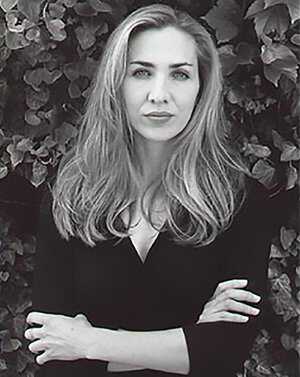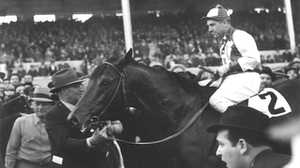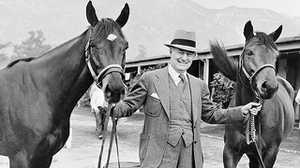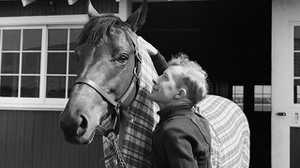Interview: Laura Hillenbrand
Best-selling author Laura Hillenbrand describes the people closest to Seabiscuit.

Charles Howard, owner
Charles Howard invented sports marketing. He would woo the press every chance he got. He didn’t want for this horse only to be successful — he wanted him to be a superstar in America.
He knew the avenue to that would be through the press. He would send barrels of champagne to the press box. He would run up to the press box after races to see if anybody wanted him to comment. He would pull Seabiscuit’s shoes off after races and have them cast into silver ash trays. He was everywhere the press was. He carried around a book filled with phone numbers of all of the press, so that he could call them and give them updates, and he made everybody feel like they had a scoop, and that encouraged everyone to cover the horse.
As a result, or largely as a result of this, Seabiscuit was the number one story in newspapers in 1938. He received more newspaper column inches than anybody else. Roosevelt was second, and Hitler was third.
Tom Smith, trainer
He took Seabiscuit out in secret, out on the Tanforan racetrack. It was just him, the horse, and an exercise rider, and it was the first time he was going to really see how fast this horse could go. And he turned the horse loose, and he actually pulled out his stopwatch this time, and he watched the horse flatten down and start really rolling on the backstretch, and Smith later said what he thought was, “He’s burning the top off the racetrack.”
The horse was absolutely flying, and he watched him bend into the turn, and the horse had this suppleness to his body when he turned. And Smith thought, no horse has ever run a turn like this one, and he kept glancing down at the watch, thinking the horse couldn’t possibly be going this fast. And the horse went under the wire, and he clicked the stopwatch, and the horse had crushed the track record. And this was in a workout. Horses rarely run as fast in workouts as they do in real races, and Smith knew what he had on his hands, and he was scared to death.
Red Pollard, jockey
He lived a terrible life, but he was a guy that didn’t allow that to defeat him. He lived as he chose even though he was not successful throughout his career. He really was not a success, he was mostly a failure. But, he did not hunker down under his fear like other people did. He stretched his life out as far as he could get it to go. He did as much as he possibly could. He did things he wasn’t really physically able to do. So that he could be as fully alive as he could possibly be. And in a time like the 1930s, that was a tremendous accomplishment. There were a lot of reasons to live a very narrow life. Red Pollard did not live a narrow life.
Agnes Conlon, Red Pollard’s wife
Agnes was kind of a funny match for Red. He was kind of everything she wasn’t. He was such an extravagant soul. He felt everything so strongly. She was a very reserved woman, a very controlled woman; aristocratic. Here was this guy with an eighth-grade formal education, a jockey; he had no home when she married him. He was crippled, he was down to 86 pounds because he had been in the hospital for close to a year. She arrived out in California and discovered her husband was an alcoholic — discovered he was treating all of his pain with alcohol. She was in deep, but she really loved this man and they were a good match in an odd way. I think she kind of answered for something, he kind of answered for something that she was lacking. And she provided him with a little bit of the civilized life. She took care of him. He needed someone to take care of him. And I think they were a good match.
George Woolf, jockey
Part of what made George Woolf such a superb jockey was his pedigree. He was the son of a mounted circus acrobat and a stagecoach driver. He spent his whole life aboard horses right from very small childhood. Riding out on the ranges in Babb, Montana, riding rodeo horses and riding match races in Indian country. This man knew horses. He knew horses better than almost anybody.
He was very, very smart and he researched every race he rode. He would go into the Daily Racing Form, and not only study his own horse but he’d study every other horse in the field looking for a weakness.
And he did something that was before its time. He would sit in the jock’s room, before a race, and close his eyes and visualize every race. People thought he was sleeping but he wasn’t. He was riding it in his mind until he found a way to win it. And when he opened his eyes he knew he was going to win the race — and he almost always did.
James “Sunny Jim” Fitzsimmons, trainer
At a race in Maryland that Seabiscuit was competing in, Seabiscuit was in the paddock. He was getting ready to be saddled. Tom Smith was standing by his head getting ready to throw the saddle over him, and an old man came out of the crowd and walked toward them. He was stooped over, and Smith recognized who it was.
It was “Sunny Jim” Fitzsimmons, Tom Smith’s idol, and Seabiscuit’s first trainer, and he came up and introduced himself to Smith as if Smith didn’t know who he was, and he said, “I hope you wouldn’t mind if I could just hold the horse’s head while you saddle him, I’d be honored.” And Smith for the one time in his career choked up, and he started to cry, and he just quietly handed the reins over to Fitzsimmons, and he saddled the horse, and then Fitzsimmons solemnly handed the reins back and walked back into the crowd.







